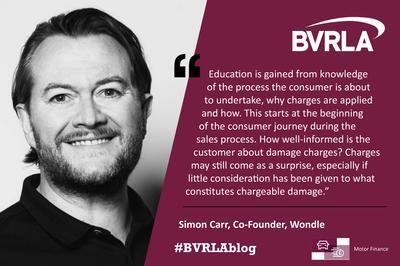Simon Carr, Co-Founder of Wondle, who provide an AI-powered vehicle damage recognition app, looks at damage in the light of Consumer Duty regulation.

Damage to vehicles is a fact of life. It affects all drivers and fleets from the most careful to the most, shall we say, unlucky?
Another fact of life for operators is that damage has a financial impact on the value of a vehicle, and someone must pay. That someone should be the person that caused it (or at least was responsible for the vehicle when the damage occurred).
The BVRLA’s Alternative Dispute Resolution (ADR) service data demonstrates that consumers find the topic of end-of-contract damage a cause for complaint. Damage is the number one cause of complaints, constituting nearly two-thirds of total complaints. This is also mirrored in Leasing company customer service statistics and public review websites, so what is going wrong?
Are leasing companies routinely mischarging customers for damage? Not according to our analysis. We regularly review retrospective charges for end-user fleets for audit purposes, numbering data sets in the thousands, and we find very few material errors from leasing companies.
So why the rising complaint rate? In our experience (we have surveyed hundreds of lease users and performed thousands of scans), there are three key factors. Education, Time and Agency. These are also the areas of great opportunity that can see customer complaints rates go down and customer satisfaction go up.
Education is gained from knowledge of the process the consumer is about to undertake, why charges are applied and how. This starts at the beginning of the consumer journey during the sales process. How well-informed is the customer about damage charges? In 2022 the average passenger car damage charge for FN50 customers was £407. Charges may still come as a surprise, especially if little consideration has been given to what constitutes chargeable damage. Who is really controlling the narrative on this? For example, do you know how many customers have downloaded the BVRLA guide or watched your informational videos? In short, can you monitor your consumers' levels of engagement with this subject across the customer journey? Do you know where your customers find the information, and is it applicable to your processes?
The Financial Conduct Authority (FCA) specifically mentions this in its March 2023 ‘Dear CEO’ letter, ‘for example, to demonstrate that any fees for fair wear and tear are suitable’. Having a platform to do that pre-sale and in life is crucial. Doing that ‘after the event’ will not effectively reduce new complaints; only attempt to answer them, and by then, the damage is done. Finding a solution to this will improve the complaint rate dramatically.
Time and timing are essential. If the first time the consumer knows the cost of damage is upon collection or, worse, the removal of funds by direct debit, they will be surprised at best and angry at worst. Giving customers time to reflect on estimated charges, cross reference against BVRLA information provided at the start of the contract and simply time to get used to the idea, and reason, for charges, helps a lot. Many customers genuinely do not know how much damage they may have incurred during the lease until it is pointed out to them; consumers need time to process this; otherwise, it can easily lead to heightened emotions and that is not the time to be having customer experience conversations, for either party.
Who likes having things done to them with seemingly little choice? This is the loudest feedback we get from consumer research on end-of-contract damage. Good outcomes come from a customer ‘being given sufficient opportunity to understand and assess their options’ (FCA FG22/5). By doing so with damage, a customer can build a picture of the context, repair versus return, for instance, improving transparency. If one is cheaper, and the consumer has time to select it, they are satisfied that the cost was at least minimised. Either way, all decisions were of the customer's own choosing and in their own time, whilst having easy access to all the options and all the facts.
We think this is precisely the type of “appropriate friction” the FCA has in mind, and given the fact that in their initial feedback in January 2023, the FCA were positive about firms “carefully considering how to give customers the information they need, at the right time, and presented in a way they can understand to make effective decisions”, Lease and Mobility businesses must consider how close to this expected standard they currently are.
And that's not all. The Financial Ombudsman Service (FOS) is also adjusting and aligning its approach to the FCA’s intentions. For example, in FOS’s website communication to customers, it outlines how it will approach cases and, amongst several points, asks “whether you were given an opportunity to repair any damage before returning the car”.
Our company Wondle has designed a highly approachable consumer-facing front end that’s easy to use for damage detection, price estimation and repair access but with a powerful analytics back end that monitors everything a lease co needs to manage consumer damage well before collection, consumer engagement tools and trend reporting to monitor and maximise the effectiveness of your damage communications and improve damage policy.
We have talked with many firms who have put a tremendous amount of work into meeting the expectations of Consumer Duty and are very well prepared. Still, we have seen the opportunity for more to be done to meet end-of-contract damage expectations. Whilst most of this blog has been focused on FCA regulation, the consumer is the focus of all our efforts. We love the Mobility space and are excited to see it evolve, grow and benefit from new technologies, and we are proud to contribute to it in the form of the Wondle technology.





